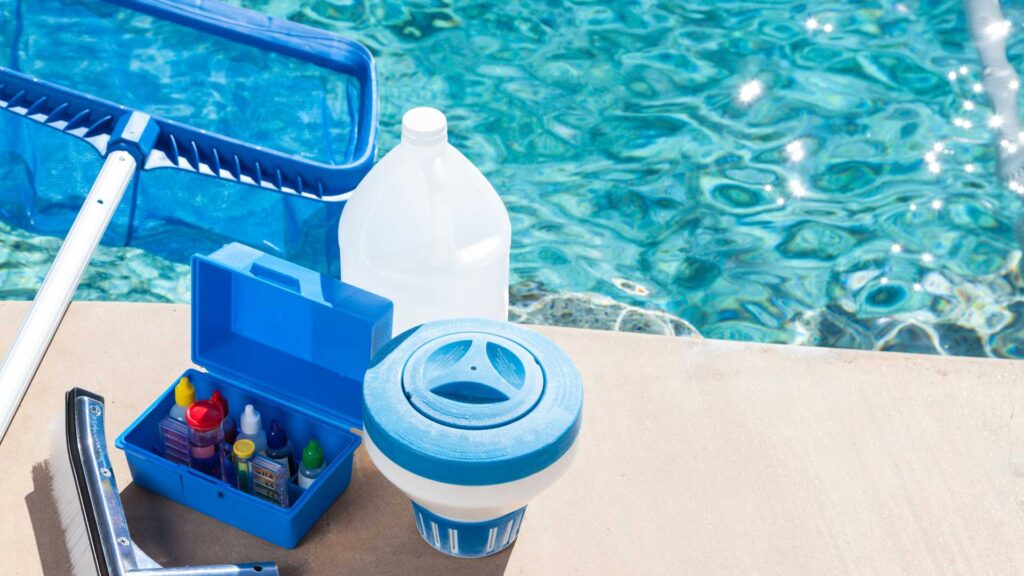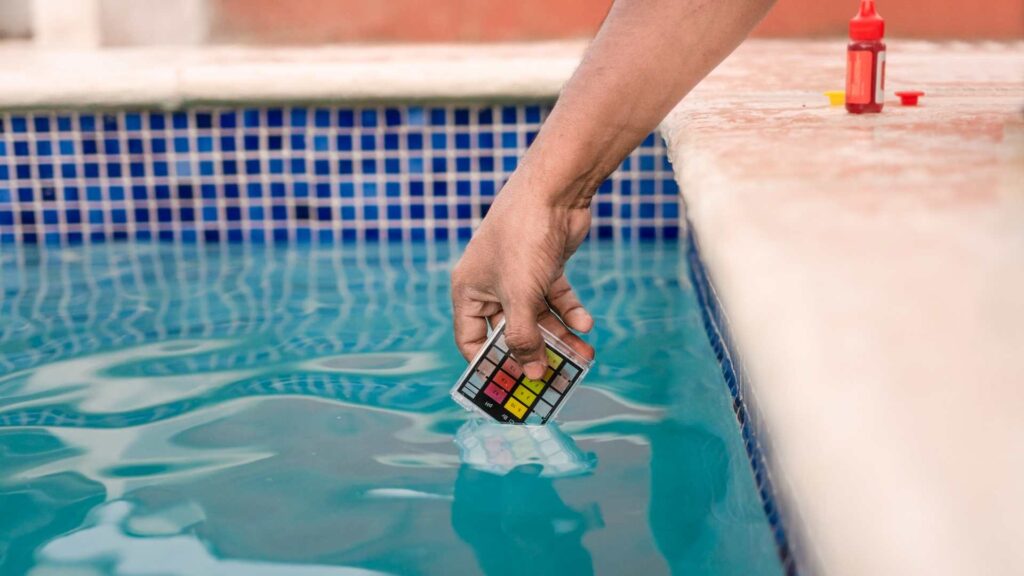The Ultimate Guide to Balancing Your Pool’s Water Chemistry
Ever wondered why your pool water sometimes looks cloudy or has an unpleasant odor? You might have heard that balancing your pool’s water chemistry is the key to maintaining a clean and enjoyable swimming experience. Well, you’re about to find out if that theory holds true. In this ultimate guide, you will discover the importance of water chemistry, learn about pH levels, alkalinity, and calcium hardness, uncover the secrets of chlorine and sanitization, and discover how to maintain the proper chemical balance. Get ready to dive into the world of pool water chemistry and uncover the secrets that will keep your pool sparkling and inviting all summer long.
Key Takeaways
- Balancing pool water chemistry is essential for maintaining a clean and safe swimming environment.
- Regularly testing water chemistry helps identify imbalances and take corrective actions promptly.
- Imbalanced water chemistry can cause skin and eye irritation for swimmers and promote the growth of harmful bacteria and algae.
- Maintaining proper chemical balance through adjusting pH levels, alkalinity, and chlorine levels, as well as regular maintenance, helps prevent algae growth and ensures clean and clear water.
Importance of Water Chemistry

Balancing pool water chemistry is crucial for maintaining a clean and safe swimming environment. Understanding the importance of water chemistry and regularly testing it is essential for pool owners and operators who desire to provide a pleasant and enjoyable experience for their guests.
Water testing methods play a vital role in ensuring that the chemical levels in the pool are balanced. These methods help measure the pH levels, chlorine levels, alkalinity, and other important factors that contribute to the overall water quality. By regularly testing the water, you can identify any imbalances and take corrective actions promptly.
The impact of imbalanced water chemistry can be significant. If the pH level is too high or too low, it can cause skin and eye irritation for swimmers. Additionally, imbalanced water chemistry can lead to the growth of harmful bacteria and algae, making the pool water unsafe and unappealing.
Understanding Ph Levels
Maintaining balanced pH levels in your pool is crucial for ensuring the safety and comfort of swimmers. pH measures the acidity or alkalinity of your pool water, and it plays a significant role in the overall water chemistry. The pH scale ranges from 0 to 14, with 7 being neutral. A pH level below 7 indicates acidity, while a pH level above 7 indicates alkalinity.
Measuring the acidity or alkaline levels of your pool can be easily done using a pH testing kit. Simply collect a water sample from your pool and follow the instructions provided with the testing kit. The results will give you an accurate reading of your pool’s pH level.
Why is maintaining balanced pH levels important? Well, if the pH levels are too high or too low, it can cause several issues. Firstly, it can lead to skin and eye irritation for swimmers. Secondly, it can affect the effectiveness of chlorine and other sanitizing agents, making it difficult to keep your pool clean and clear. Lastly, imbalanced pH levels can also cause damage to your pool equipment and surfaces over time.
To maintain balanced pH levels, you can use pH increasers or pH reducers. These chemicals will help bring the pH levels back to the optimal range of 7.2 to 7.6. Regularly testing and adjusting the pH levels will ensure that your pool water remains safe, comfortable, and enjoyable for everyone.
Balancing Alkalinity and Calcium Hardness

To effectively balance the alkalinity and calcium hardness of your pool water, you need to understand their importance in maintaining water chemistry. Alkalinity refers to the ability of water to resist changes in pH levels, while calcium hardness measures the amount of dissolved calcium in the water. Both of these factors play a crucial role in keeping your pool water balanced and healthy.
| Alkalinity Testing | Calcium Hardness Adjustment |
|---|---|
| Regularly test the alkalinity levels of your pool water using a testing kit. | Adjust the calcium hardness of your pool water by adding calcium chloride or calcium increaser. |
| Ideal alkalinity levels should be between 80 and 120 parts per million (ppm). | The recommended calcium hardness range is between 200 and 400 ppm. |
| If alkalinity levels are too low, add alkalinity increaser to raise the levels. | If calcium hardness levels are too low, add calcium chloride to increase the levels. |
Maintaining proper alkalinity and calcium hardness levels is essential for preventing pH fluctuations, corrosion, and scale buildup in your pool. Low alkalinity levels can lead to acidic water, which can damage pool equipment and irritate swimmers’ skin and eyes. On the other hand, high alkalinity can cause cloudy water and reduce the effectiveness of sanitizers. Similarly, low calcium hardness can result in the water becoming aggressive and seeking to balance itself by extracting calcium from pool surfaces, causing damage. Conversely, high calcium hardness can lead to scale buildup on pool surfaces and equipment.
Chlorine and Sanitization

Have you ever wondered how chlorine and sanitization play a crucial role in keeping your pool water clean and safe for swimming? Proper maintenance of chlorine levels is essential for maintaining a healthy and enjoyable pool environment. Here are four reasons why chlorine and sanitization are vital for your pool:
- Kills bacteria and algae: Chlorine acts as a powerful disinfectant, killing harmful bacteria and preventing the growth of algae in your pool water. This helps to maintain a safe and sanitary swimming environment.
- Prevents waterborne illnesses: Chlorine is effective in eliminating waterborne pathogens, such as E. coli and Giardia, which can cause illnesses. By maintaining appropriate chlorine levels, you can protect yourself and others from getting sick while swimming.
- Controls pH levels: Chlorine also helps to regulate the pH levels in your pool water. When chlorine is properly balanced, it can prevent the water from becoming too acidic or alkaline, which can cause discomfort or damage to swimmers and pool equipment.
- Ensures water clarity: Chlorine not only kills bacteria and algae but also helps to maintain crystal clear water. It eliminates particles and debris that can cloud the water, ensuring a visually appealing and inviting swimming experience.
To ensure the effectiveness of chlorine and sanitization in your pool, regular testing and proper pool maintenance are essential. By monitoring and adjusting chlorine levels as needed, you can enjoy a clean and safe swimming pool all season long.
Maintaining Proper Chemical Balance

Properly balancing the chemicals in your pool is essential for maintaining a safe and enjoyable swimming environment. Testing the water quality regularly is crucial to ensure that the chemical levels are within the recommended range. This helps prevent the growth of algae and ensures that the water is clean and clear.
To maintain the proper chemical balance, it is important to regularly test the water using a reliable testing kit. This will help you determine the pH level, alkalinity, and chlorine level in your pool. Adjusting these levels as needed is crucial to keep the water safe for swimming.
Preventing algae growth is another key aspect of maintaining proper chemical balance. Algae can quickly multiply in a pool with imbalanced chemicals, leading to a green and slimy pool. To prevent algae growth, it is important to maintain the chlorine level within the recommended range. Additionally, regularly brushing and vacuuming the pool, as well as keeping the water circulation system in good condition, can help prevent algae from taking hold.
Frequently Asked Questions
How Often Should I Test My Pool Water for Chemical Balance?
You should test your pool water for chemical balance regularly to ensure the water is safe and clean. It’s important to maintain the right levels of chemicals to prevent algae growth and protect your pool equipment.
Can I Use Household Bleach Instead of Chlorine for Sanitizing My Pool?
You can use household bleach instead of chlorine to sanitize your pool, but there are pros and cons to consider. Bleach may be less expensive, but it can affect pH levels and may not be as effective at killing bacteria and algae.
What Are the Potential Health Risks of Swimming in a Pool With Imbalanced Water Chemistry?
Swimming in a pool with imbalanced water chemistry can pose potential health risks. Imbalances can lead to skin and eye irritation, respiratory problems, and even infections. It’s crucial to maintain proper water chemistry for a safe swimming experience.
How Does Rainfall Affect the Chemical Balance of My Pool Water?
When it rains, the pH balance of your pool water can change. Rainwater is usually acidic, so it can lower the pH level. High chlorine levels can help combat this and keep your pool water balanced.
Are There Any Specific Pool Chemicals I Should Avoid Using Together to Prevent Adverse Reactions?
To prevent adverse reactions in your pool, avoid using certain pool chemicals together. This is important for pool chemical safety and avoiding chemical reactions that could harm your pool or even yourself.
External Links for reference:
- Recreonics offers an overview of basic water chemistry principles for swimming pools, emphasizing the importance of balancing factors like total alkalinity, pH, calcium hardness, and chlorine levels. This resource is particularly useful for understanding the foundational aspects of pool water chemistry. You can explore more at Recreonics.
- Medallion Energy provides a practical guide on how to balance your pool water in seven easy steps. This guide covers adjusting pH levels, calcium hardness, and chlorine, among other factors. It’s a great resource for practical, step-by-step instructions. Find more detailed information at Medallion Energy.
- Latham Pool presents a comprehensive guide on pool water chemistry, including how to test your pool water chemicals and the best methods for balancing them. This resource is particularly valuable for its detailed explanation of different testing methods and the steps required to achieve chemical balance in pool water. More information can be found at Latham Pool.





 Alex Cota
Alex Cota  Sophie Pekic
Sophie Pekic Rudy Reyes
Rudy Reyes  Mark Harlan
Mark Harlan Kevin Hall
Kevin Hall  Howard (Howie) Van Lare
Howard (Howie) Van Lare  Chris Cavalerro
Chris Cavalerro 

 Betty Garmendina
Betty Garmendina George Wallace
George Wallace Zach Zastrow
Zach Zastrow Jorge Salazar Bernal
Jorge Salazar Bernal Mike Watson
Mike Watson Jane Ciuchta – Hired 2015
Jane Ciuchta – Hired 2015 Bruce Muir – Hired 2020
Bruce Muir – Hired 2020 David-Metzger – Hired 2014
David-Metzger – Hired 2014 Robin Clarke – Hired 2019
Robin Clarke – Hired 2019 Maddi Davidson – Hired 2022
Maddi Davidson – Hired 2022 John Albachten – Hired 2015
John Albachten – Hired 2015 Jay Bergmann – Hired 2023
Jay Bergmann – Hired 2023 Summer Venegas – Hired 2017
Summer Venegas – Hired 2017 Rebecca Jones – Hired 2015
Rebecca Jones – Hired 2015 Jane Doe – Hired 2014
Jane Doe – Hired 2014